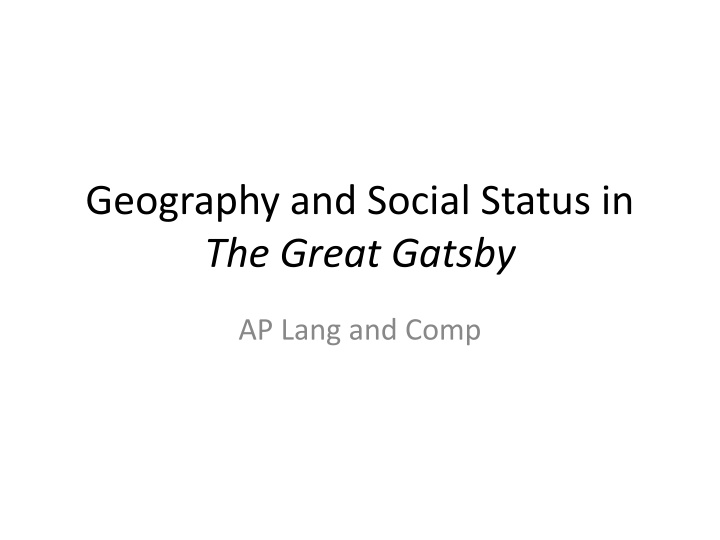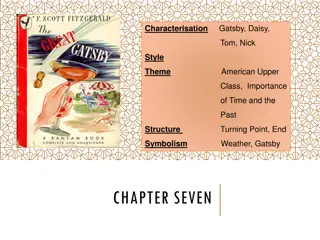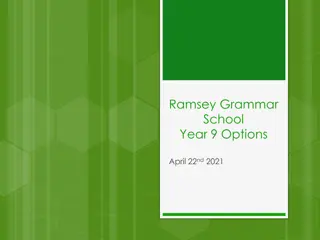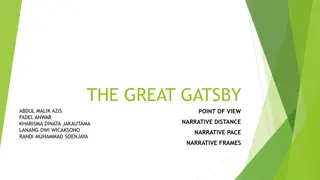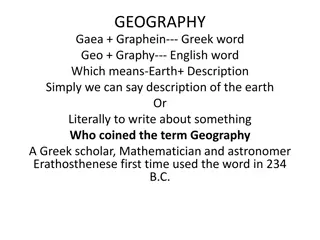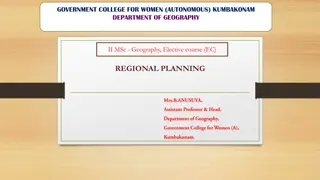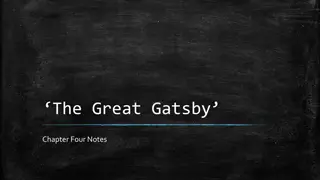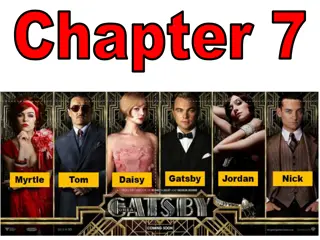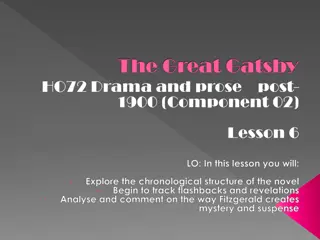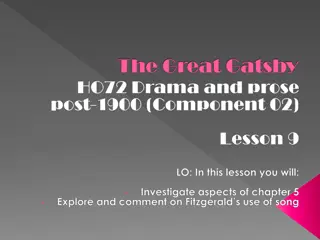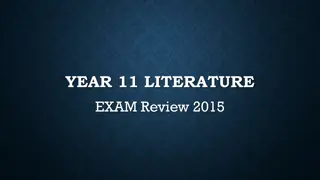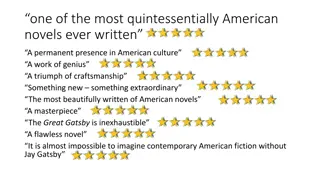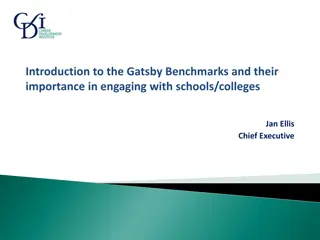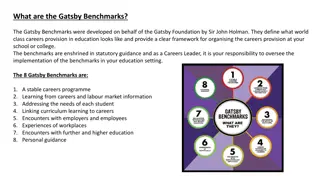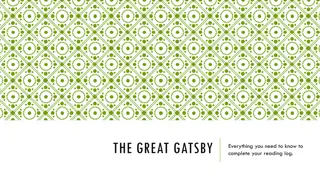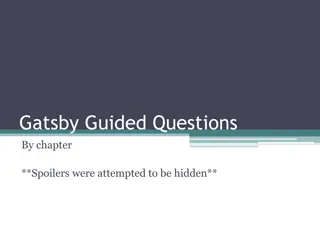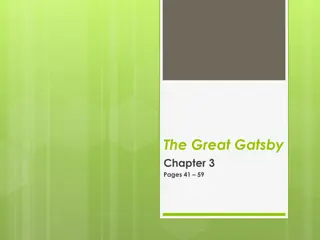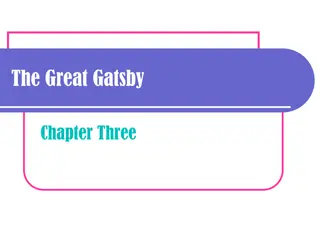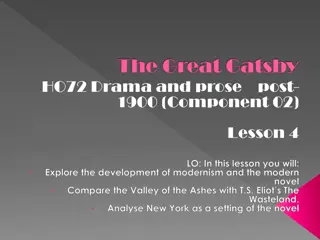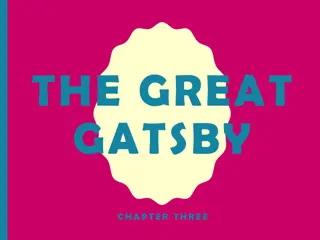The Geography and Social Status in The Great Gatsby
The Great Gatsby by F. Scott Fitzgerald explores the impact of geography on social status. Through the contrasting settings of West Egg, East Egg, and the Valley of Ashes, the novel delves into the disparities between characters residing in these locations. Fitzgerald incorporates real places as backdrops, such as Great Neck and Manhasset, to further emphasize the societal divides. The narrative unfolds within the intricate interplay of landscapes, reflecting the characters' aspirations, struggles, and the pursuit of the American Dream.
Uploaded on Sep 28, 2024 | 2 Views
Download Presentation

Please find below an Image/Link to download the presentation.
The content on the website is provided AS IS for your information and personal use only. It may not be sold, licensed, or shared on other websites without obtaining consent from the author.If you encounter any issues during the download, it is possible that the publisher has removed the file from their server.
You are allowed to download the files provided on this website for personal or commercial use, subject to the condition that they are used lawfully. All files are the property of their respective owners.
The content on the website is provided AS IS for your information and personal use only. It may not be sold, licensed, or shared on other websites without obtaining consent from the author.
E N D
Presentation Transcript
Geography and Social Status in The Great Gatsby AP Lang and Comp
Chapters 1-3 Claim: Although fiction, Fitzgerald uses real places as the backdrop of The Great Gatsby.
It was a matter of chance that I should have rented a house in one of the strangest communities in North America. It was on that slender riotous island which extends itself due east of New York and where there are, among other natural curiosities, two unusual formations of land (Fitzgerald 4).
Where is one such slender riotous island which extends itself due east of New York?
Great Neck represents Fitzgerald's _________and Manhasset represents ________.
Fitzgerald's "Valley of Ashes" is actually set in what we know as Queens. Queens was nowhere near as urban as Manhattan, nor as pastoral as the Eggs; in fact, it was rather desolate.
This is the valley of ashes- a fantastic farm where ashes grow like wheat [and] take the forms of houses and chimneys and rising smoke (Fitzgerald 23).
It was a bleak industrial wasteland ...in which the forgotten plans of yesterday echoed throughout (Fitzgerald 24).
One of the three stops was a garage- Repairs. George B. Wilson. Cars bought and sold (Fitzgerald 25).
The bleakness and poverty of the Valley of Ashes contrasts greatly with the wealth and opulence of high society's Manhattan
The Gilded Age The Gilded Age
The Gilded Age The Industrial Revolution fueled a small class of American entrepreneurs, innovators, and businessmen who made millions of dollars over a short period of time. Proud of their accomplishments, they reveled in their wealth and wanted everyone around them to know how successful they were. They expected to enjoy the same status as other wealthy people now that they, too, were rich.
West Egg Like the Rockefeller s, Fitzgerald was new to the wealthy class and wanted to be accepted by his new peers. Fitzgerald s House Gatsby s House I lived in West Egg well, the less fashionable of the two, though this is a most superficial tag to express the bizarre and not a little sinister contrast between them (Fitzgerald 5).
East Egg Old money families like the Astors looked down on the newly rich or nouveau riche as a lower social class, even though their financial class rivaled that of the old money families. Astor s Home Buchanans Home
Why would Fitzgerald base the setting of the book off of real places?
Chapters 4-6 Claim: Meyer Wolfsheim is based on notorious Jewish gangster, Arnold Rothstein.
A small, flat nosed Jew raised his large head and regarded me with tow fine growths of hair which luxuriated in either nostril. After a moment I discover his tiny eyes in the half darkness (69).
Meyer Wolfsheim is thought to be based on popular Jewish Gangster, Arnold Rothstein. Arnold Rothstein Arnold Rothstein Meyer Meyer Wolfsheim Wolfsheim Four syllables Traditional Jewish Name Stereotypical Jewish characteristics Four syllables Traditional Jewish Name Stereotypical Jewish characteristics
Meyer Wolfsheim? No he s a gambler. He s the man who fixed the World Series back in 1919 (73). I remembered of course, that the World Series had been fixed in 1919, but if I had thought of it at all I would have though of it as a thing that merely happened, the end of some inevitable chain. It never occurred to me that one man could start to play with the faith of fifty million people with the single mindedness of a burglar blowing a safe (73).
1919 Series between the Chicago White Sox and the Cincinnati Reds. Gives the reader insight into not only the naivety of the narrator Nick Carraway, but also shows the type of people Jay Gatsby is in business with. Wolfshiem comes across as dishonest and crooked, which, in turn, directly reflects on Gatsby. Arnold Rothstein allegedly offered $100,000 to some 7-9 players to intentionally lose the World Series. The connection of Wolfshiem and Rothstein is blatent, as Fitzgerald mentions him being Jewish and fixing the World Series, Rothstein s claim to fame.
Juxtapose Zelda Fitzgerald Daisy Buchanan
Juxtapose F. Scott Fitzgerald Jay Gatsby
So what? Fitzgerald s Gatsby and Daisy The first selfie ?
If Fitzgerald bases his story off of real people and real places, why make Gatsby fiction rather than non-fiction?
Chapters 7-9 Claim: Though Fitzgerald would have no way of foreseeing the stock market crash of 1929, the world he presents in The Great Gatsby is clearly headed for disaster.
The problem with having a single dream: C: Fitzgerald is warning readers that if one puts everything they have into attaining one thing, and in the end don t achieve what it is they want, they will be left with nothing. W: Gatsby s efforts are focused and wasted on Daisy, and when her love for him doesn t prove resilient, his whole life begins to deteriorate. In this way Gatsby s ambition becomes his tragic flaw. I: The book serves as a commentary of Americans of the day, and in a way can be seen as a foreshadowing of the Great Depression. Being completely irresponsible and frivolous can be fun for a while but, as seen through the events of the novel, will not prove to have positive results.
1920s 1930 s
Fitzgerald the Psychic: The more Gatsby endeavored to acquire, the less he was left with, which is what Fitzgerald is primarily advising his readers to be wary of. Like with the green light, the opportunity and glamour of the times in America began to recede before the publics eyes as the Great Depression came about. Though, Fitzgerald could have no way of foreseeing the stock market crash of 1929, the world he presents in The Great Gatsby seems to be clearly headed for disaster. In this way Fitzgerald s novel became an even more accurate depiction of the times than he realized; the people of America thought they were unassailable just as Gatsby did, and then came the stock market crash and the Great Depression.
Gatsby Final Paper Step 1: Research the 1920s, Fitzgerald, the Jazz Age, The Lost Generation, etc. Step 2: Brainstorm a. What is Fitzgerald arguing? b. How does he argue it? c. Why does he use fiction or satire as a form of argument? Step 3: Use credible research and the textual evidence from the book to write a well-developed analytical research essay.
